

Home - Conservation International. The Global Food Challenge Explained in 18 Graphics. This post is part of WRI's blog series, Creating a Sustainable Food Future.
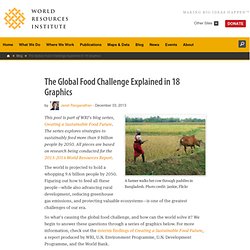
The series explores strategies to sustainably feed more than 9 billion people by 2050. All pieces are based on research being conducted for the 2013-2014 World Resources Report. The world is projected to hold a whopping 9.6 billion people by 2050. Raising EU Citizen's Awareness of Their Role in Development Issues: Livestock and Climate Change.
Using slogans such as ‘Eat Food From Family Farms’, and ‘Healthy People, Animals and Environment’, Veterinaires Sans Frontieres Europa (VSFE) manage a number of projects that support small-scale livestock farmers as they adapt to climate change in vulnerable locations.
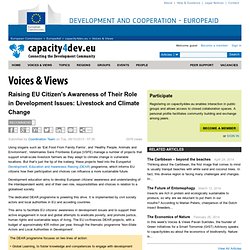
But that’s just the tip of the iceberg: these projects feed into the EuropeAid Development, Education and Awareness Raising (DEAR) programme, which informs EU citizens how their participation and choices can influence a more sustainable future. Development education aims to develop European citizens' awareness and understanding of the interdependent world, and of their own role, responsibilities and choices in relation to a globalised society. The dedicated DEAR programme is powering this drive.
It is implemented by civil society actors and local authorities in EU and acceding countries. The Biofuels FAQs: The Facts About Biofuels: Ethanol. As of February 2007, the ethanol production capacity of the United States was estimated at 5.6 billion gallons per year.
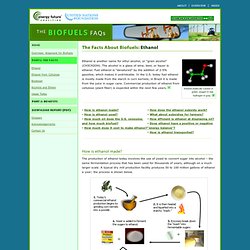
An additional capacity of 6.2 billion gallons per year was under construction, which will bring the total capacity to 11.8 billion gallons per year spread across 23 states. Nourish: Food + Community. Download tools that encourage systems thinking. Help visualize where our food comes from and how it gets to us. Sign up for our mailing list to receive updates from Nourish. Explore this richly detailed visualization of our food system ▶ Nourish Food System Map 11″ x 14″ poster (PDF), 18” x 24” poster (PDF) ▶ Pair with the Nourish Food System Map Study Guide (PDF) The Story of our Food. Is Local Food Better? Editor's note: The local-food movement has been gaining momentum in developed countries, and in many developing countries as well, in recent years; in the United States alone, sales of locally grown foods, worth about $4 billion in 2002, could reach as much as $7 billion by 2011.
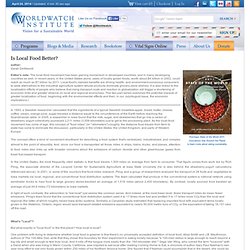
Local food's claimed benefits are driving health- and environment-conscious consumers to seek alternatives to the industrial agriculture system whose products dominate grocery-store shelves. It is also linked to the localization efforts of people who believe that rising transport costs and reaction to globalization will trigger a shortening of economic links and greater reliance on local and regional economies. This two-part series examines the potential impacts of greater localization of food, beginning with the environmental effects and then, in our July/August issue, the economic implications.) In light of such contrasts, the admonition to "eat local" just seems like common sense. What's "Local"? THE ATLAS OF FOOD by Myriad Editions. Food monopolists are taking over the world food supply. The place of food: mapping out the ‘local’ in local food systems.
Canadian Foodgrains Bank - Rebalancing the Global Food Supply. This three-part series, written by Stuart Clark, originally appeared in the Winnipeg Free Press in July 2011.

Part One: It’s a New World Originally printed in the Winnipeg Free Press July 23, 2011. The global food system can seem a complicated thing. It involves farmers, buyers, speculators, governments and many others, all affected by weather, politics and other factors. An easy way to understand it is to think of it is as a water bucket. For about 50 years, the system worked fine.
Throw in changing weather patterns—things like drought or, as happened this year on the Canadian prairies, too much rain—and production can’t keep up with demand. It wasn’t always this way. Today, that’s all changed. How did we get into this situation? Despite the fact that human population doubled over the past 40 years, food production was always able to keep up with demand. So what changed? In China, for example, annual meat consumption has jumped from three to 60 kilograms per person over the past 50 years. What Is the Vulnerability of a Food System to Global Environmental Change? Carolyn Steel: How food shapes our cities. The Pleasures of Eating - Wendell Berry. Ecoliteracy.org The Pleasures of Eating Many times, after I have finished a lecture on the decline of American farming and rural life, someone in the audience has asked, "What can city people do?

" "Eat responsibly," I have usually answered. Of course, I have tried to explain what I mean by that, but afterwards I have invariably felt there was more to be said than I had been able to say. Now I would like to attempt a better explanation. I begin with the proposition that eating is an agricultural act. Most urban shoppers would tell you that food is produced on farms. Local Food Systems: Selected Resources. Local Food Systems: Selected Resources Elizabeth Berman Science & Engineering Librarian Bailey/Howe Library University of Vermont Burlington, Vermontelizabeth.berman@uvm.edu Copyright 2011, Elizabeth Berman.
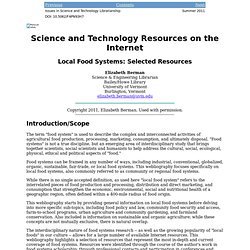
Used with permission. Introduction/Scope The term "food system" is used to describe the complex and interconnected activities of agricultural food production, processing, marketing, consumption, and ultimately disposal. The Determinants of Food Choice. The True Cost of Cheap Food. Cheap food causes hunger.

On its face, the statement makes no sense. Stress on the environment, society and resources? Author and Page information by Anup ShahThis Page Last Updated Tuesday, September 18, 2001 Do large populations affect and put stress on the environment, society and resources?
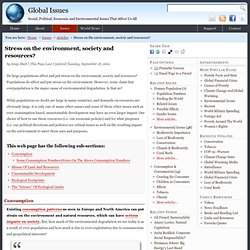
Populations do affect and put stress on the environment. However, some claim that overpopulation is the major cause of environmental degradation. Agricultural Footprint. VID Land Use for Food.